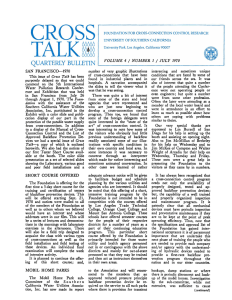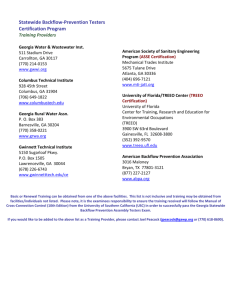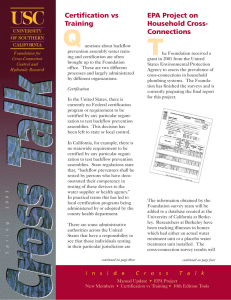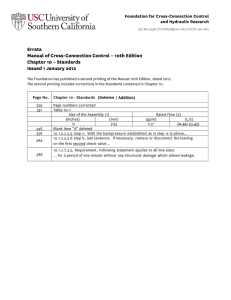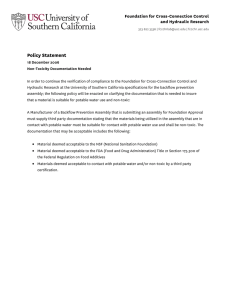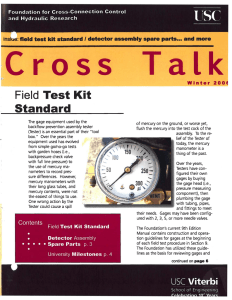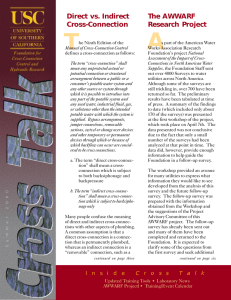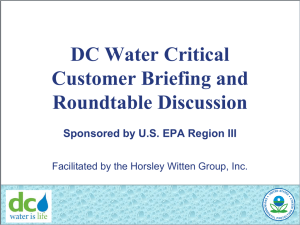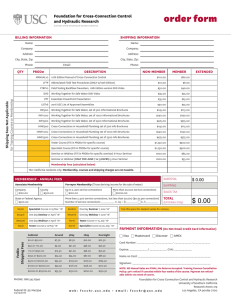T M Approved List AwwaRF Report
advertisement
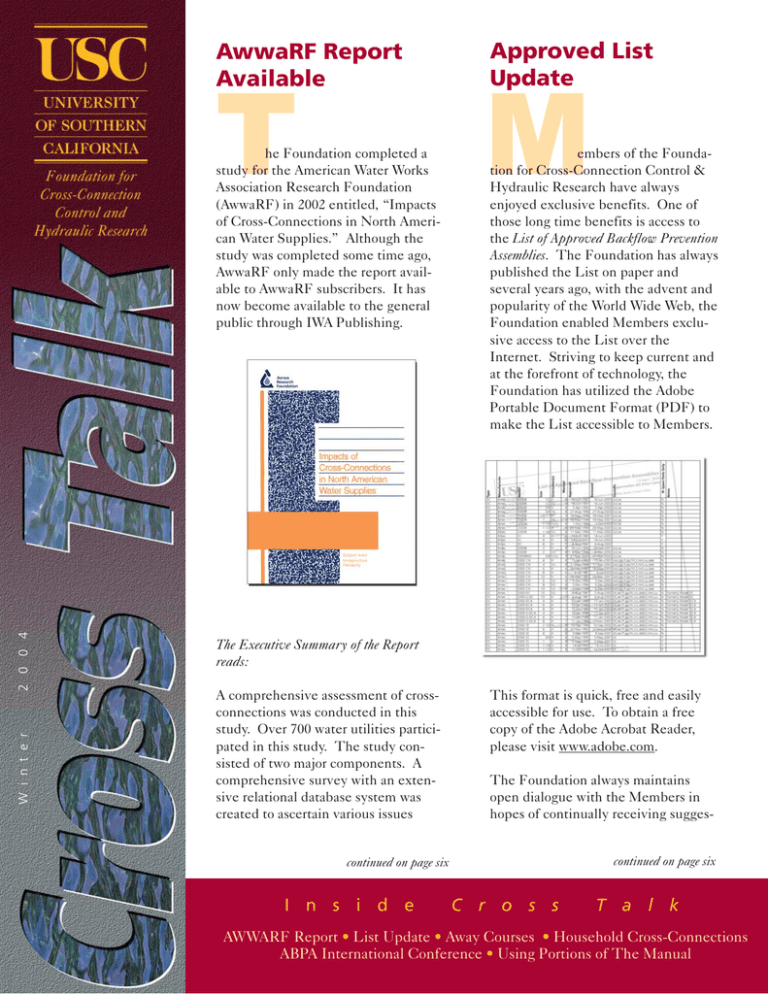
AwwaRF Report Available Approved List Update T M W i n t e r 2 0 0 4 he Foundation completed a study for the American Water Works Association Research Foundation (AwwaRF) in 2002 entitled, “Impacts of Cross-Connections in North American Water Supplies.” Although the study was completed some time ago, AwwaRF only made the report available to AwwaRF subscribers. It has now become available to the general public through IWA Publishing. embers of the Foundation for Cross-Connection Control & Hydraulic Research have always enjoyed exclusive benefits. One of those long time benefits is access to the List of Approved Backflow Prevention Assemblies. The Foundation has always published the List on paper and several years ago, with the advent and popularity of the World Wide Web, the Foundation enabled Members exclusive access to the List over the Internet. Striving to keep current and at the forefront of technology, the Foundation has utilized the Adobe Portable Document Format (PDF) to make the List accessible to Members. The Executive Summary of the Report reads: A comprehensive assessment of crossconnections was conducted in this study. Over 700 water utilities participated in this study. The study consisted of two major components. A comprehensive survey with an extensive relational database system was created to ascertain various issues This format is quick, free and easily accessible for use. To obtain a free copy of the Adobe Acrobat Reader, please visit www.adobe.com. The Foundation always maintains open dialogue with the Members in hopes of continually receiving sugges- continued on page six continued on page six I n s i d e C r o s s T a l k AWWARF Report • List Update • Away Courses • Household Cross-Connections ABPA International Conference • Using Portions of The Manual T Foundation Membership he Foundation’s Membership Program provides many benefits to the Members of the Foundation. These include: twenty percent discount on Foundation Training Courses for any employee of the Member company/organization, the List of Approved Backflow Prevention Assemblies, printed quarterly, and access to the up-to-the-minute version of the List for those Members with Internet access. Members are encouraged to call the Foundation with technical questions. The Foundation’s Engineering Staff is available to assist Members with the various aspects of field testing backflow preventers, installing backflow preventers and administering their cross-connection control program. Below is a list of those who’ve recently become members of the Foundation: Azle, City of Edgewood Water Company Contacting the Foundation Firebaugh, City of Fanshawe College, Canada Fire Ace G & C Enclosures Govatos Professional Corp. Hawaii, State of Heffington, Galen Idaho DEQ Lee Enterprises Southeast, Inc. Leathers, Robert Maintenance Tracking Systems, Inc. Mohawk College, Canada Rogers Water Utility Mailing Address: Foundation for CrossConnection Control and Hydraulic Research University of Southern California Kaprielian Hall 200 Los Angeles, CA 90089-2531 Phone: 866 545 6340 213 740 2032 Toll Free FAX: 213 740 8399 e-mail: fccchr@usc.edu Web Site: www.usc.edu/fccchr Sauters Plumbing & Backflow TVA Fire & Life Safety Two Yanora Tech The Foundation accepts Purchase Orders via mail or fax and credit card orders (Visa, MasterCard, Discover) via telephone and the Web. Cross Talk is published by the Foundation for Cross-Connection Control and Hydraulic Research at the University of Southern California for Foundation Members. Limited additional copies are available to Members upon request. 2004 © University of Southern California. All rights reserved. Household CrossConnections E arly in 2003, the Foundation completed the study, “Prevalence of Cross-Connections in Household Plumbing Systems.” This study, funded by the US Environmental Protection Agency, involved site surveys of almost 200 homes in Davenport, IA. The purpose was to determine the extent of cross-connections in household plumbing systems. This study also tied into another study also funded by the USEPA, which was to determine if water treatment units at the homes had any correlation with the number of gastrointestinal illnesses, which occurred in the homes during the time of the study. The cross-connection portion was added to determine if there was a correlation between the gastrointestinal illnesses and the cross-connections at the residences. The University of California at Berkeley conducted the study on gastrointestinal illnesses. This was called the Water Evaluation Trial or WET Study. The cross-connection study, conducted by the Foundation, is complete and the final report will be available on the Foundation’s web site within the next few weeks. Once the final approval is given by the EPA, the report will be posted. The conclusion of the report reads, in part, as follows: cross-connections in the home. Many of these cross-connections can be corrected by simple measures, such as a hose bib vacuum breaker or the change in a toilet fixture. Other problems which may occur, such as a direct cross-connection to the sewer via a water softener, would require some additional plumbing work to alleviate. The fact that 73% of all The fact that 73% water uses were through unprotected cross-connections indicate that there is of all water uses a significant chance for backflow to occur should the hydraulic conditions were through change. Events that are not uncommon, such as a water main unprotected cross- break or fire hydrant use (for firefighting or flushing), would drop connections indi- the pressure at the incident to atmospheric pressure. Pressure in cate that there is the piping system elevated above the main break could drop to sub- a significant atmospheric levels. In such cases, backflow would occur through these chance for unprotected cross-connections. A problem within the home could also backflow to occur occur should the water supply to the home be shut-off for any maintenance should the hy- reason. If a tap at a lower elevation were opened, backflow would occur draulic conditions through an unprotected crossconnection. change. Please make sure to check the Foundation’s web site (www.usc.edu/ fccchr) for the full report. The results indicate that there are a large number of unprotected Three Away Training Courses S Typically fifty backflow prevention assemblies are shipped with fifteen test stands to allow ample opportunity for those in attendance to practice the field test procedures. everal times each year the Foundation offers its courses at locations away from the Los Angeles area. This year courses are planned for Mesa, AZ; Incline Village, NV; and Honolulu, HI. The course in Mesa, Arizona is taking place right about the time you receive this issue of Cross Talk. It is a Program Specialist Course hosted by the City of Mesa Utilities Department. The course will take place in a department training room with the site surveys taking place at various Utility facilities in the area. The Arizona Department of Environmental Quality agreed to grant certification to those who successfully complete the course. A Tester Course will be held in Incline Village, NV this summer (9-13 August 2004). The Foundation has held courses in Incline Village for years, but has not for the last couple of years because of construction on the facilities being used. This year, the Tester Course is back on schedule and we hope to offer a Specialist Course in Incline Village in the Spring of 2005. The Incline Village General Improvement District hosts these courses. Four The State of Hawaii is cohosting a course with the Honolulu Board of Water Supply in the Fall. The dates should be confirmed in the next week or so. This will be a Tester Course. Offering a Tester Course at locations not within driving distance of Los Angeles has always been a bit problematic. A large amount of equipment is needed for the Tester Course. Typically fifty backflow prevention assemblies are shipped with fifteen test stands to allow ample opportunity for those in attendance to practice the field test procedures. When it is necessary to ship this equipment any amount of distance (especially across the ocean), timing is critical. The equipment must be shipped early enough to ensure delivery before the course and it must be returned in time for the next Foundation Tester Course. To alleviate this problem, the State of Hawaii along with the Board of Water Supply in Honolulu, have offered to construct test stands and provide backflow preventers fitted in the same manner the Foundation modifies them for Foundation Courses. This allows the Foundation instructors to simulate problems with the assembly, enabling the course attendee to test and diagnose the various conditions of the assemblies. continued on page seven ABPA International Conference E very year the American Backflow Prevention Association hosts an International Conference and Tradeshow for those interested in protecting drinking water from contamination through crossconnections. This year’s event is being held in Long Beach, CA on May 9-12, 2004. Being in southern California, the Foundation will be actively involved throughout the week. The Foundation’s Director, Dr. J.J. Lee, will be making a presentation on “Understanding Hydraulics & How Backflow Happens.” Other Foundation staff will also be preparing information and workshops throughout the week. The event will also carry an array of presentations dealing with timely issues in the cross-connection field including “Service or Internal Protection-Which is Better?” and “Identifying Cross-Connections During Plan Review.” In addition to these, the event will also have workshops on “Field Testing the RP & PVB” and “Field Testing the DC & SVB.” The Foundation will have a booth in the exhibitor’s area where you will be able to find information and interact with several of the Foundation’s staff that will be at the conference. The ABPA International Conference is the perfect opportunity to learn about the latest breakthroughs in the field along with making contacts that can help you as you become involved in the cross-connection control field. The City of Long Beach is a prime location to hold the conference. It gives attendees the opportunity to visit several of southern California’s most popular tourist attractions including the Queen Mary, Aquarium of the Pacific and Hollywood. To learn more about the ABPA International Conference and Tradeshow please visit our web site (www.usc.edu/fccchr) and The ABPA International Conference is the perfect opportunity to learn about the latest breakthroughs in look for our ‘Events of Interest’ calendar where you can find a link to the conference. We look forward to seeing you there. the field ... Join us at the ABPA International Conference in Long Beach, CA on May 9-12, 2004 Five AwwaRF Report continued from page one The North American survey data indicates that more and more agencies developed programs over the last three decades. As more agencies developed programs, more related to cross-connections. Computer simulations were conducted for three different sized water distribution systems, ranging from small to large. Several scenarios were simulated to study the transient effects of rapid changes in demand. List Update continued from page one The Summary and Conclusion Section includes the following: No geographic trends were found in North America in relation to the type of cross-connections being experienced. Indirect cross-connections account for 65% of the cross-connections while 35% are direct crossconnections. The North American survey data indicates that more and more agencies developed programs over the last three decades. As more agencies developed programs, more incidents were reported. Therefore, the reporting of incidents has continually increased since 1975. It is important, however, to note that the average number of incidents being reported per agency does not significantly change. This suggests that the number of incidents per utility isn’t necessarily changing over time, but that reporting is becoming more prevalent as agencies develop crossconnection control programs. incidents were reported. To order this report you will have to contact IWA Publishing (www.iwapublishing.com). The Foundation does not carry copies and cannot provide copies. IWA lists a publication date of March of this year with a list price of $205.00. The overall average cost for all sizes of water utilities is $44,835 spent annually on administering the crossconnection control program. On the average, 3.65% of the agencies’ operations and maintenance budget were directed towards cross-connection control. tions on how to improve service. The Foundation will continue to offer access to the List in the very flexible and common pdf format. Additionally, the Foundation has recently made the List available in Microsoft Excel spreadsheet format. Using this format, Members are able to take advantage of all the functions available to Excel users. Searching, sorting and finding assemblies will be easier than ever before. Additionally, each product is listed on a separate line. In the past, when products were approved simultaneously, they appeared as one listing with the various sizes and orientations (e.g., 1/2”, 3/4”, 1” (H, VU)). With the new List, each individual model, size and orientation will be listed on a separate line. This enables the user to sort by any variable to find the specific parameters being sought. Access to the List will remain similar to the way the List is currently accessed. Members who wish to view the List may access our web site at www.usc.edu/fccchr. From there, one of two choices may be chosen. By clicking the appropriate icon whether one has a password or not will direct Members either to the List or to the process of receiving a password and being put on our Membership email list for notification whenever the List Six continued on page seven Using Portions of The Manual T he Manual of Cross-Connection Control - Ninth Edition has been a very popular tool among training institutions. Additionally, many administrative authorities have adopted the field test procedures as the required method of testing under their jurisdiction. The Foundation receives requests regularly for permission to reproduce sections of the Manual. Many of these requests come from water agencies or health departments wishing to use the installation guidelines from Section 8 (Figures 8.1 through 8.4). In some cases the Model Ordinance from Section 8 is desired. In most of these cases, the Foundation will grant permission for use of these portions, depending upon the intended use of the material. The field test procedures from Section 9 of the Manual (in the fully illustrated version) may not be reproduced under any circumstances. The Foundation has not and will not grant permission for use of the fully illustrated version of the field test procedures. These are available only in the Ninth Edition of the Manual of the Cross-Connection Control. The Nonillustrated Field Test Procedures for Backflow Prevention Assemblies may be available to certifying entities if the administrative authority requires these procedures. Permission to use or reproduce the procedures may be requested from the Foundation office. The administrative authority making the request must agree to use the Nonillustrated Field Test Procedures for Backflow Prevention Assemblies in its entirety with no editing. Additionally, they may not be distributed at random, but may be distributed upon request only. For more information, please contact the Foundation office. The procedure is quite simple and many certifying entities have taken advantage of the Foundation’s Non-illustrated Field Test Procedures for Backflow Prevention Assemblies. ...many certifying List Update continued from page six changes. Both the Excel version and the PDF version will be available for download to Foundation Members. entities have adopted the field test procedures as the required method of Away Courses continued from page four Registration for all of the Foundation Courses, whether in Los Angeles or away, is always handled through the Foundation Office. Those interested in hosting a course away from the Los Angeles area may download hosting information from the Foundation’s web site (www.usc.edu/fccchr). Hosting information may be found under Frequently Requested Documents. testing under their jurisdiction. Seven Training Courses Tester Course Los Angeles, CA 17-21 May 2004 Los Angeles, CA 12-16 July 2004 Upcoming Events ABPA Region IV Conference •Ft. Worth, TX 14-17 March 2004 AWWA CA/NV Proctor Training •Sacramento, CA 18 March 2004 Incline Village, NV 9-13 August 2004 Utah ABPA Conference •Salt Lake City, UT 19 March 2004 Specialist Course AWWA CA/NV Spring Conference •Las Vegas, NV 12-16 April 2004 Mesa, AZ 23-27 February 2004 Los Angeles, CA 26-30 July 2004 Foundation for Cross-Connection Control and Hydraulic Research School of Engineering University of Southern California Kaprielian Hall 200 Los Angeles, California 90089-2531 ABPA- 20th Annual International Conference & Trade Show •Long Beach, CA 9-12 May 2004 First Class US Postage PAID University of Southern California
